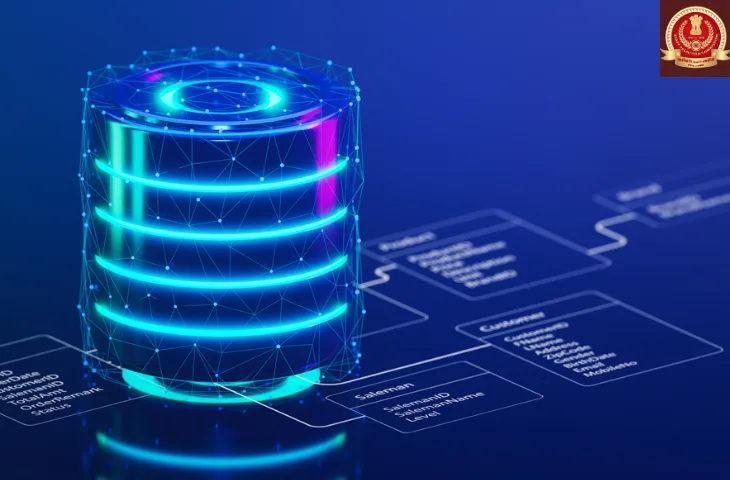Database and SQL are among the most important topics in the Computer Awareness section of SSC CGL Tier 2. Questions from this topic test your understanding of how data is stored, organized, and managed in computer systems. Having basic knowledge of databases and SQL commands helps you answer these questions quickly and accurately.
What is a Database?
A database is an organized collection of data that can be easily accessed, managed, and updated. It stores information in a structured format, usually in tables made up of rows and columns. Databases are used in almost every sector from banking systems to government offices to store and retrieve information efficiently.
Types of Databases
Databases can be categorized based on their structure and use. Understanding the types of databases helps you know how different systems store and manage data.
| Type of Database | Description |
| Relational Database (RDBMS) | Stores data in tables related by keys (e.g., MySQL, Oracle, SQL Server). |
| Hierarchical Database | Data is stored in a tree-like structure (e.g., IBM IMS). |
| Network Database | Data is represented using records and links (e.g., Integrated Data Store). |
| Object-Oriented Database | Stores data as objects, similar to programming languages (e.g., ObjectDB). |
| Distributed Database | Data is stored across multiple systems but acts as a single database. |
Important Database Terminologies
Before learning SQL, it’s important to understand some key database terms that form the foundation of this topic.
| Term | Meaning |
| Table | Collection of rows and columns where data is stored. |
| Row (Record) | A single entry or data item in a table. |
| Column (Field) | A specific attribute or data type in the table. |
| Primary Key | Unique identifier for each record in a table. |
| Foreign Key | Links two tables together using a common field. |
| Schema | The structure that defines how data is organized in a database. |
Also check out: SSC CGL Typing Test Errors to minimize your errors in Data Entry Speed Test.
What is SQL?
SQL (Structured Query Language) is used to communicate with and manage databases. It helps in performing actions such as inserting, updating, deleting, and retrieving data from tables. SQL is easy to learn and is used in most database management systems like MySQL, Oracle, and PostgreSQL.
Check out SSC CGL Exam Notification
Common SQL Commands
SQL commands are divided into categories based on their function. The table below lists some of the most commonly used SQL commands for SSC exams.
| Command Type | Examples | Purpose |
| DDL (Data Definition Language) | CREATE, ALTER, DROP | Used to define and modify the structure of database objects. |
| DML (Data Manipulation Language) | INSERT, UPDATE, DELETE | Used to modify data within the database. |
| DQL (Data Query Language) | SELECT | Used to retrieve data from the database. |
| DCL (Data Control Language) | GRANT, REVOKE | Used to control access permissions. |
| TCL (Transaction Control Language) | COMMIT, ROLLBACK | Used to manage transactions in a database. |
Basic SQL Queries for Practice
Here are a few simple SQL queries that help in understanding how SQL commands work. You can expect conceptual questions like these in SSC exams.
| Purpose | SQL Query Example |
| To create a table | CREATE TABLE Students (ID INT, Name VARCHAR(50), Age INT); |
| To insert data | INSERT INTO Students VALUES (1, 'Rahul', 21); |
| To fetch all data | SELECT * FROM Students; |
| To update data | UPDATE Students SET Age = 22 WHERE ID = 1; |
| To delete data | DELETE FROM Students WHERE ID = 1; |
Advantages of Using Databases
Databases make data handling more systematic and efficient. Below are some key advantages:
- Easy data storage and retrieval
- Reduces data duplication and inconsistency
- Supports multiple users simultaneously
- Provides data security and backup
- Enables data sharing and better decision-making
Key Takeaways
Below are the key takeaways:
- A database stores data in an organized manner.
- SQL is used to manage and manipulate data in databases.
- Understanding basic SQL commands like
SELECT,INSERT,UPDATE, andDELETEis important for SSC CGL Tier 2. - Relational databases are the most commonly used type.
- Regular practice of SQL-based questions improves accuracy in the Computer Awareness section.
FAQs
Questions are mostly conceptual, focusing on topics like database structure, SQL commands, keys, and types of databases.
A database is an organized collection of data stored in tables, which can be easily accessed, updated, and managed.
SQL (Structured Query Language) is used to manage and retrieve data from databases. Understanding SQL helps in solving Computer Awareness questions quickly.
The main types are DDL (Data Definition Language), DML (Data Manipulation Language), DQL (Data Query Language), DCL (Data Control Language), and TCL (Transaction Control Language).
A primary key uniquely identifies each record in a table, while a foreign key links one table to another using a shared field.

I’m Mahima Khurana, a writer with a strong passion for creating meaningful, learner-focused content especially in the field of competitive exam preparation. From authoring books and developing thousands of practice questions to crafting articles and study material, I specialize in transforming complex exam-related topics into clear, engaging, and accessible content. I have first hand experience of 5+ months in SSC Exams. Writing, for me, is not just a skill but a way to support and guide aspirants through their preparation journey one well-written explanation at a time.
